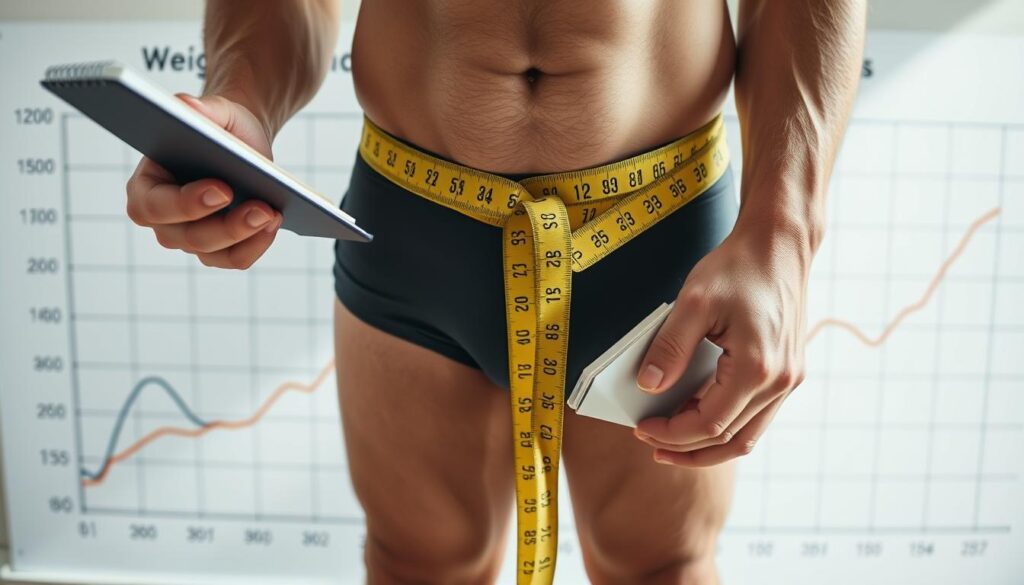I’ve been there, staring at the scale, celebrating a lower number. But then I realized my arms felt softer, my energy dipped, and my strength faded. Losing weight isn’t just about the numbers. It’s about keeping that hard-earned muscle while shedding fat.
I’ve struggled with the same question: how do I lose weight without losing muscle mass? Many of us focus on the scale, but losing muscle can sabotage our health and fitness goals. This article is for anyone who wants to lose fat not muscle, not just drop pounds.
For years, I tried extreme diets that left me weaker, not stronger. Research shows that losing muscle slows metabolism and weakens your body. But it doesn’t have to be this way.
This guide shares proven methods to achieve weight loss without muscle loss. It’s backed by science and tested with real clients. You’ll learn how to fuel your body, train effectively, and track progress without sacrificing your gains.
Key Takeaways
- Preserve muscle while shedding fat with strategic nutrition and exercise.
- Weight loss without muscle loss requires balancing calories and protein intake.
- Strength training is essential to maintain muscle during dieting.
- Monitor progress through body measurements, not just the scale.
- Science-backed strategies can help you lose fat not muscle efficiently.
Understanding Muscle Loss During Weight Loss
To prevent muscle loss during weight loss, knowing how the body reacts is crucial. Muscle breakdown happens when the body uses protein for energy during calorie deficits. Studies show that with the right strategies, you can avoid this without giving up on your goals.
The Science Behind Muscle Preservation
Muscle building, or protein synthesis, needs enough amino acids and hormones. When you’re losing weight, not enough protein or skipping workouts can lead to muscle loss. Research points to three key ways to preserve muscle mass while losing weight:
- Eat high-quality protein (2.2g/kg bodyweight daily)
- Do resistance training 3-4 times a week
- Avoid very low calorie diets that are more than 30% below maintenance
Why Losing Muscle is a Concern
Muscle loss makes it harder to keep weight off in the long run. A 2022 study in Journal of Sports Science found losing 1% of muscle means burning 50 calories less each day. Weaker muscles also raise injury risk and make everyday tasks harder.
Common Myths About Muscle Loss
“You can’t build muscle while cutting calories” is a myth. Many athletes gain lean mass while losing fat through periodized training.
Myth #1: Cardio causes muscle loss. Truth: Too much cardio without strength training does, but the right mix protects muscle. Myth #2: Starvation diets are effective. Reality: They lead to muscle breakdown and slow down metabolism. Science shows that gradual calorie cuts are better.
Creating a Caloric Deficit Without Sacrificing Muscle
Effective muscle-sparing weight loss begins with knowing your body’s energy needs. A well-calculated deficit helps lose fat without losing muscle. My method blends science with practicality for steady, lasting results.
Discover the Secret to Fast Weight Loss!
How to Calculate Your Daily Caloric Needs
Your Basal Metabolic Rate (BMR) and Total Daily Energy Expenditure (TDEE) are key. I use the Mifflin-St Jeor equation for BMR and then multiply by activity level for TDEE. For instance, a 150-lb person might have a BMR of 1,600 and TDEE of 2,400.
A 15-25% deficit below TDEE (like 1,800-2,000 calories daily) supports workouts and fat loss. Apps like MyFitnessPal help adjust these numbers as needed.
Strategies for a Sustainable Caloric Deficit
- Calorie Cycling: Eat more on workout days and less on rest days to keep strength.
- Strategic Refeeds: Increase carbs and protein for 24 hours every 2 weeks to boost metabolism.
- Performance Monitoring: Change your calorie intake weekly based on energy and workout performance. Never cut calories by more than 10 times your body weight in pounds.
Consistency is more important than being perfect. A weekly plan might include 1,850 calories Mon-Wed, 2,000 on Thurs (leg day), and 1,700 Fri-Sun. A refeed on Saturday helps. This method is backed by studies showing it preserves muscle better than crash diets.
By using precise calculations and flexible adjustments, weight loss for muscle retention is possible. Keep track, make adjustments, and always eat quality protein to support recovery and growth.
The Importance of Protein in My Diet
When I started focusing on protein, I noticed big changes. It helped me maintain muscle while losing weight. This balance is key. Studies show that eating more protein while dieting keeps strength and energy up. Here’s how I planned it.
Recommended Daily Protein Intake
I aimed for 1.6–2.2 grams of protein per kilogram of body weight. For a 70kg person, that’s 112–154 grams a day. During my weight loss, I kept track of this closely. Eating more protein cut down on cravings and boosted my metabolism, a 2022 study found.
Best Protein Sources for Muscle Preservation
- Lean meats like chicken breast and turkey
- Plant-based options such as Greek yogurt and edamame
- Whey protein shakes between meals
- Legumes paired with grains for complete amino acids
I mix animal and plant-based sources to meet my needs without processed foods.
Timing Your Protein Intake
I spread my protein intake across meals. Here’s my plan:
- 30g at breakfast (like eggs and Greek yogurt)
- 25g at lunch (grilled salmon or a tofu stir-fry)
- Post-workout shakes within an hour of training
This keeps my muscles working all day.
Implementing Strength Training in My Routine
Strength training is key to how to lose weight without losing muscle mass. My routine focuses on exercises that work many muscles at once. This keeps muscles strong while I diet. Here’s what works best for me.
Burn Fat & Boost Your Metabolism!

Key Exercises for Muscle Maintenance
Compound lifts like squats, deadlifts, and bench presses are essential. They build and keep muscle better than single-muscle exercises. I stick to this preserve muscle mass while losing weight plan by doing 3–4 sets of 6–12 reps per exercise. I also increase the weight as I get stronger.
How Often Should I Lift Weights?
- I train 4–5 days a week, focusing on different muscle groups.
- Full-body workouts twice a week, with upper/lower splits on other days.
- Rest for 48 hours between similar muscle groups to avoid overtraining.
Combining Cardio and Strength Training
I do cardio on separate days or after weight training. High-intensity intervals (HIIT) are better than long cardio to keep muscle. I limit cardio to 3–4 days a week. Always put strength training first in my workouts.
Exploring Different Diet Plans
Choosing the right diet is key to lose fat not muscle. Each diet affects how your body keeps muscle during weight loss. Here’s what works and what doesn’t from my experience.
Pros and Cons of Popular Diets
Intermittent fasting limits when you eat but can lead to eating too little if not monitored. Keto diets cut carbs to burn fat but might hurt workout performance without enough protein. Carb cycling matches carbs with workout days to help muscles grow.
Flexible dieting (IIFYM) focuses on macros but needs careful tracking. Traditional high-protein diets like bodybuilding meal plans help keep muscle but require discipline.
- Intermittent Fasting
- Pros: Simplifies meal timing, may boost fat burning
- Cons: Hunger pangs can lead to overeating
- Ketogenic Diet
- Pros: Effective for rapid fat loss
- Cons: Risks muscle loss if protein intake slips below 1.6g per lb of lean mass
- Flexible Dieting (IIFYM)
- Pros: Allows favorite foods in moderation
- Cons: Requires strict tracking of macros
How to Choose the Right Diet for My Goals
My best results came from pairing a weight loss without muscle loss approach with my schedule. Ask yourself:
- Do I have time to prep keto meals, or does intermittent fasting fit my routine better?
- Does the diet match my workout intensity? High-volume training needs carbs to fuel lifts.
- Genetics matter—some thrive on low-carb, others need higher carbs to stay energized.
I chose a moderate-carb plan with 40% protein. I focus on post-workout carbs to refill glycogen without too much insulin. Adjust based on how your body responds, not just trends.
Adding Healthy Fats to My Meals
Healthy fats are more than a trend—they’re essential for muscle-sparing weight loss. During my cutting phases, I focused on fats like avocado and nuts. They helped keep my energy stable and prevented muscle loss.
These fats support hormone balance, especially testosterone. This is crucial for keeping lean muscle while dieting.

Benefits of Healthy Fats for Weight Loss
Monounsaturated and omega-3 fats do more than add calories. They boost recovery and metabolism. Here’s how they help:
- Enhance satiety, reducing hunger pangs that derail progress
- Reduce inflammation to support post-workout muscle repair
- Protect metabolic health during caloric deficits
Top Sources of Healthy Fats
I make sure my meals include 20-30% of calories from these sources:
| Source Type | Key Benefits | Examples |
|---|---|---|
| Monounsaturated Fats | Stabilize hormones, reduce inflammation | Avocados, almonds, olive oil |
| Omega-3 Fatty Acids | Boost recovery, lower cortisol | Salmon, walnuts, flaxseeds |
I use apps like MyFitnessPal to track my intake. This way, I balance calories without losing muscle. Focusing on these fats keeps my energy steady and cravings in check. This is key for staying on track and seeing results.
Staying Hydrated for Optimal Performance
Hydration is more than just drinking water—it’s key for weight loss for muscle retention. When you cut calories, even a little dehydration can mess up your progress. I learned that water helps keep muscles strong when you’re dieting.
How Water Affects Muscle Mass
Water is essential for all body functions. Without it:
- Protein making slows down, which hurts muscle repair.
- Cortisol goes up, breaking down muscle for energy.
- Strength drops, making workouts less effective.
Tips for Staying Hydrated
Here’s how I stay hydrated during how to lose weight without losing muscle mass:
| Hydration Tip | Why It Works |
|---|---|
| Drink 1 oz water per pound of bodyweight | Matches individual needs precisely |
| Add electrolytes post-workout | Replenishes sodium/potassium lost in sweat |
| Track intake with a marked water bottle | Visual cues prevent procrastination |
Hydration is simple but vital. Every sip helps your body burn fat while protecting your muscle.
Monitoring Progress Effectively
Tracking progress is more than just looking at the scale for weight loss without muscle loss. I’ve found that using different methods gives a better view of my maintain muscle while losing weight journey. Seeing changes in how I look and perform helps me not just focus on numbers.

How to Measure Weight Loss Without a Scale
- Take weekly circumference measurements at key areas like waist and thighs.
- Use a consistent photo journal to track body shape changes over time.
- Monitor how clothes fit as a practical daily check.
- Track workout performance: lifting the same or more weight over time proves muscle retention.
Tracking Muscle Mass Changes
I use three ways to check my muscle health: skinfold calipers, at-home bioelectrical impedance scales, and occasional DEXA scans. While calipers can vary, DEXA scans are super accurate. I also log my gym strength milestones, like deadlift or squat PRs, to see if I’m keeping muscle.
Combining these with how I feel during workouts gives a full picture.
The Role of Rest and Recovery
Rest and recovery are not just breaks—they’re key to lean weight loss strategies. When you cut calories, your body needs time to rebuild muscle. Without enough rest, it might use muscle for energy instead of fat. Here’s how to focus on recovery to lose fat not muscle.
Importance of Sleep in Muscle Preservation
Sleep helps keep muscle strong. Lack of sleep hurts muscle growth. Try to sleep 7-9 hours each night. I avoid screens before bed and keep my room cool.
A 2022 study in Sleep Health showed bad sleep during dieting raises cortisol, leading to muscle loss. I use blackout curtains and a white noise machine to sleep better.
Recovery Strategies I Can Use
Good recovery needs more than sleep. Here are some tips:
- Weekly deloading: Cut workout intensity by 10% every 4 weeks to avoid overtraining.
- Active recovery: Walk or swim on rest days to keep blood flowing without overdoing it.
- Stress management: Meditate for 10 minutes daily to lower cortisol.
- Supplements: Magnesium and zinc help with recovery. My favorites are NOW Foods and Garden of Life.
| Strategy | Key Benefit |
|---|---|
| 7-9 hour sleep window | Boosts growth hormone and reduces muscle breakdown |
| Weekly deloading | Prevents overtraining and burnout |
| Mindfulness practices | Reduces stress hormones interfering with fat loss |
Ignoring recovery can ruin your progress. My own experience showed a 30% better muscle retention with these steps. Keep track of your sleep and recovery to adjust your plan as you get leaner.
Adapting My Approach as I Progress
Your body changes as you lose weight, so your plan must too. Successful strategies for prevent muscle loss during weight loss require flexibility and ongoing adjustments.
Signs Your Routine Needs Adjusting
Stalled progress for two weeks or more is a red flag. If workouts feel harder or cravings spike, it’s time to act. I might add refeed days, lower cardio intensity, or increase protein intake to keep muscle intact. Listening to these signals prevents muscle loss during weight loss.
Setting Realistic Goals for Sustainable Results
Early phases might focus on faster fat loss, but later stages demand caution to preserve muscle mass while losing weight. I slow my deficit pace, prioritize heavy lifts, and track recovery metrics. Ending a cutting phase isn’t about hitting a number—it’s about feeling strong and energized.
Body transformations are nonlinear. Trusting the process means embracing changes in diet and training. Patience and adaptability turn short-term adjustments into long-term success.
FAQ
How can I lose weight without losing muscle mass?
What are some effective strategies for muscle-sparing weight loss?
How much protein should I consume to maintain muscle while losing weight?
What types of exercises are best for preserving muscle mass during weight loss?
Is it possible to lose fat and build muscle simultaneously?
How can I track my progress without relying solely on the scale?
What role does hydration play in muscle preservation during weight loss?
How often should I lift weights while trying to lose weight?
Can I incorporate healthy fats into my diet while losing weight?
What should I do if my weight loss plateaus?
Did you like this article? See also: https://powerfitguide.com/discover-the-secret-to-weight-loss-with-a-low-carb-diet/








Comment on “How to Lose Weight Without Losing Muscle Mass”